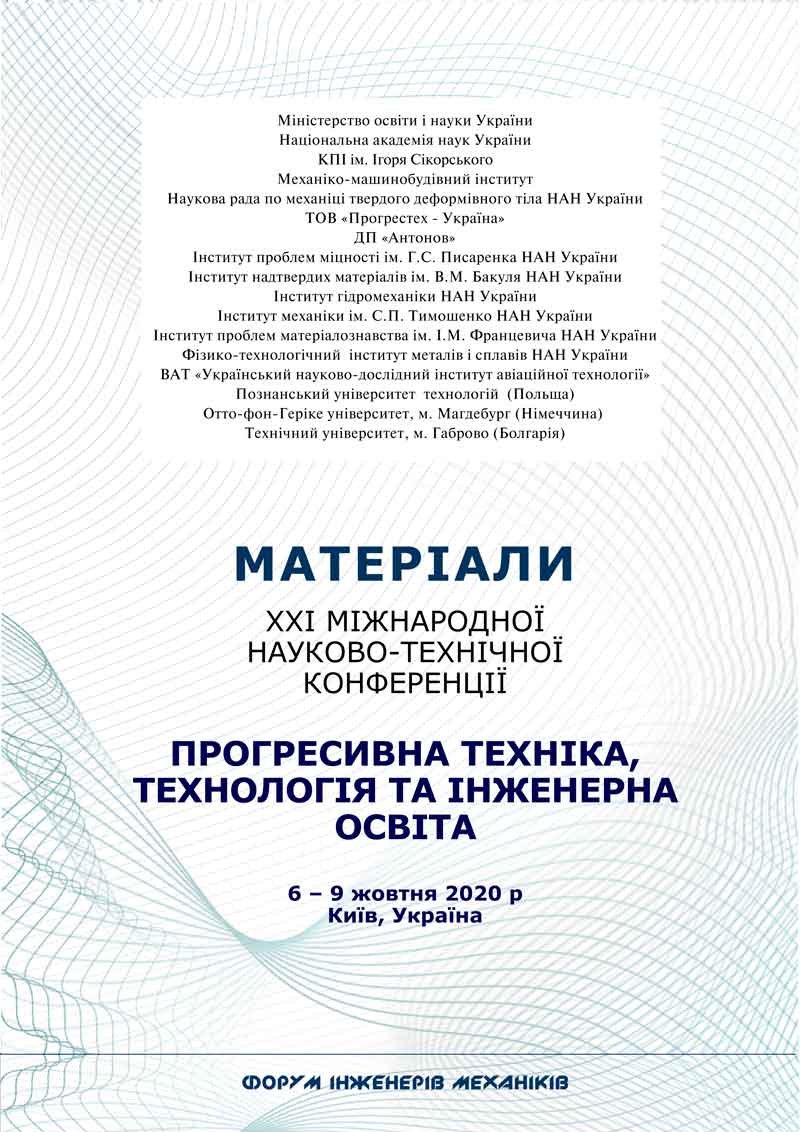Correlation between static indentation and micro cutting marble-based material
DOI:
https://doi.org/10.20535/2409-7160.2020.XXI.202819Ключові слова:
micro-cutting, brittle, static indentation, ductile modeАнотація
Defining how the chip is formed during micro-cutting can be extremely difficult. The reason is the miniaturization of the process itself in relation to the macro cutting, as well as, the smaller depth of cut in relation to the tool tip radius. Besides, the micro-cutting mechanism is influenced also by the material being machined, as well as the processing conditions. Considering that marble is brittle by its nature, the micro-cutting mechanism does not match that defined for various types of steel, aluminum, etc. Experimental analysis revealed that during the micro-cutting of marble, two different processing modes occur. In the first (ductile mode) micro-cutting is based only on the elastic and plastic deformations. In the second, which corresponds to the brittle fracturing mode, the chip is created by the formation and uncontrolled growth of the cracks within the material. The critical depth of cut that separates the two modes can be determined in many ways, and one of them is the static indentation. In addition, this method can also be used to identify the types of cracks that occur during micro-cutting in a brittle fracturing mode, which is done in this paper.Посилання
- Chiaia, B. Fracture mechanisms induced in a brittle material by a hard cutting indenter. International Journal of Solids and structures, 2001, 38.44-45: 7747-7768.
- Lee W. B.; Chen, Y. P. Simulation of micro-indentation hardness of FCC single crystals by mechanism-based strain gradient crystal plasticity. International Journal of Plasticity, 2010, 26.10: 1527-1540.
- Pjević, M. Investigation of the tool tip radius and the cutting speed influence on the quality indicators in micro cutting the materials based on marble and. Doctoral dissertation, University of Belgrade, Faculty of Mechanical Engineering, 2019.
- Gong, J.; Wu, J.; Guan, Z. Examination of the indentation size effect in low-load vickers hardness testing of ceramics. Journal of the European Ceramic Society, 1999, 19.15:2625–2631.
- Sidjanin, L.; Rajnovic, D.; Ranogajec, J.; Molnar, E. Measurement of vickers hardness on ceramic floor tiles. Journal of the European ceramic Society. 2007, 27.2:1767–1773.
- Quinn, J. B.; QUINN, G. D. Indentation brittleness of ceramics: a fresh approach. Journal of Materials Science, 1997, 32.16:4331–4346.
- Ramamurty, U.; Jana, S.; Kawamura, Y.; Chattopadhyay, K. Hardness and plastic deformation in a bulk metallic glass. Acta Materialia, 2005, 53.3:705–717.
##submission.downloads##
Опубліковано
Як цитувати
Номер
Розділ
Ліцензія
Автори, які публікуються у цьому журналі, погоджуються з такими умовами:
- Автори залишають за собою право на авторство своєї роботи та передають журналу право першої публікації цієї роботи на умовах ліцензії CC BY 4.0, яка дозволяє іншим особам вільно розповсюджувати опубліковану роботу з обов'язковим посиланням на авторів оригінальної роботи та першу публікацію роботи у цьому журналі.
- Автори мають право укладати самостійні додаткові угоди щодо неексклюзивного розповсюдження роботи у тому вигляді, в якому вона була опублікована цим журналом (наприклад, розміщувати роботу в електронному сховищі установи або публікувати у складі монографії), за умови збереження посилання на першу публікацію роботи у цьому журналі.
- Політика журналу дозволяє і заохочує розміщення авторами в мережі Інтернет (наприклад, у сховищах установ або на особистих веб-сайтах) рукопису роботи, як до подання цього рукопису до редакції, так і під час його редакційного опрацювання, оскільки це сприяє виникненню продуктивної наукової дискусії та позитивно позначається на оперативності та динаміці цитування опублікованої роботи.

